In Defense Of Postman’s Plot
Since NEWaukee's additions, the space was used and activated all summer long.
Earlier this year, I wrote that there are two things that Milwaukee needs to do in order to move forward: to invest more deeply in connectivity and to finally shed our collective aversion to risk.
Mr. Blau’s op-ed about Postman’s Plot is yet another example of Milwaukee’s resistance to change and new approaches to public space projects.
Let us set the record straight about this temporary public space experiment and hopefully enliven a larger discourse about how to inspire civic engagement in public space and to collect public feedback prior to making massive public investment.
First, NEWaukee is a social architecture firm, which invests in the artist community by commissioning them to create all sorts of works of art. We are not artists, but believe that bringing an artist to the center of community and real estate development will result in better public spaces for everyone to enjoy.
By implementing low-cost, privately funded (by NEWaukee) interventions, the aspects people use can be invested in to be more permanent and the features people do not use can be removed. The thought is that we can save public money before investing in permanency and making parks more adaptive to the surrounding community. All the furniture was movable, temporary and inexpensive. Over the duration of the installation, NEWaukee studied behavior in the park to track what installations are being used. We worked with the surrounding businesses and neighbors to continually solicit input for future improvements.
The reason we are taking this approach to public space is because dollars are drying up for public works projects. If we took this approach to public space maybe we would have ended up with a O’Donnell Park that is functional, a MacArthur Square where the public wants to gather, a Riverwalk that would have been built wider for bike access and even a Cathedral Square that was built with a stage.
Conceptually, the design of Postman’s Plot is a response to the rich diversity of constraints and opportunities that the site provides. That is, the design simultaneously responds to its historical significance and geographic location, sun angles and context, while adapting to the requirements of the budget and the human experience. More specifically, the design utilizes a series of interventions that serve as a toolkit for social engagement. This grouping of aesthetically coordinated built forms respond to the needs of the existing community (lunch hour office-use passersby) as well as the new community of residents beginning to once again call Westown home.
Like all experiments, we had some interesting findings:
- Despite some weather damage, nothing was stolen from the park. (Note: the pictures used in Mr. Blau’s piece were not accurate. NEWaukee fixed the broken chairs and signs throughout summer as we found them.)
- The letterbox actually worked! We received hundreds of love letters from residents, employees and tourists with positive feedback about the park and the city of Milwaukee.
- The number one solicitation we received was that neighbors (and their dogs) wanted a waste receptacle. Who knew the biggest constituent of the park, our four-legged friends, would benefit so greatly from this temporary installation?
- The stage wasn’t used once. We had imagined pop-up performances taking place, but it turns out that’s not the highest and best use of the space. Luckily, a huge of sum of public money wasn’t spent on it only to find it wouldn’t be used long-term.
- People used the space! From pop-up beer garden events to community dinner parties, for what is probably the first time in the park’s history, the space was activated all summer long.
When it comes down to building community there are people that talk and complain and there are people that act. From all the work we have done in Westown, you can probably make the conclusion on what side of the fence NEWaukee falls on.
Finally, NEWaukee doesn’t own the park; it is City of Milwaukee property. We are really grateful to the city for being so progressive and open to this type of experimentation. Our intention was simply to kickstart the use of underutilized space in a neighborhood we love. Debating aesthetics, what should be installed permanently, how it should be programmed — all of that describes NEWaukee’s mission — to change the way people connect.
Op ed by Jeremy Fojut, co-founder and Chief Idea Officer at NEWaukee. For more information about NEWaukee, please visit: www.newaukee.com.

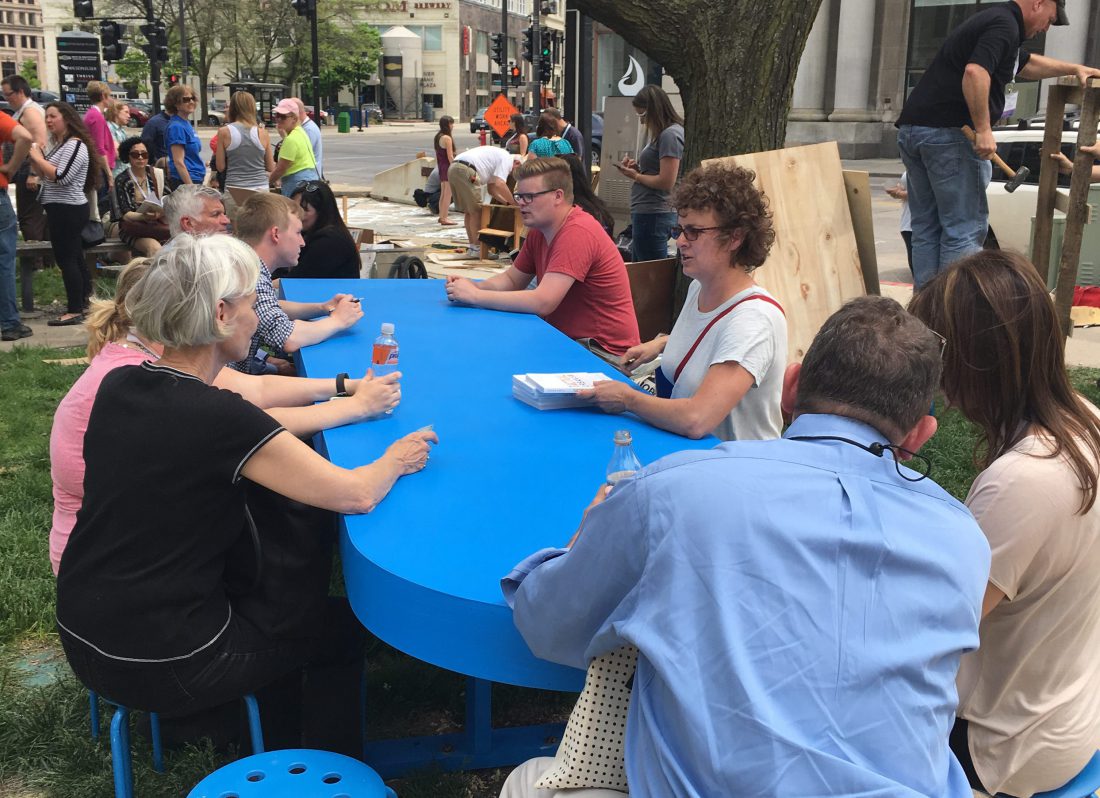
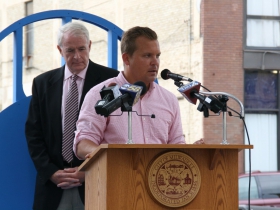
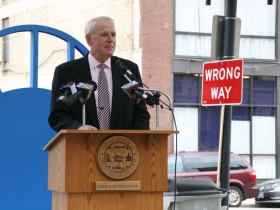
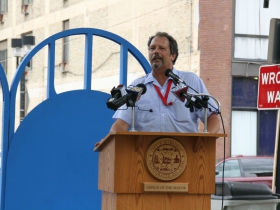
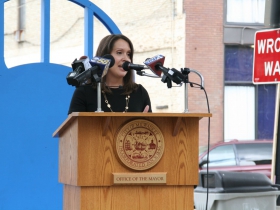
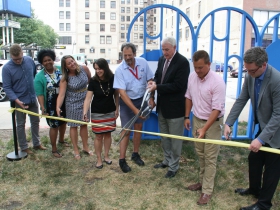
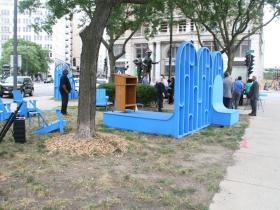
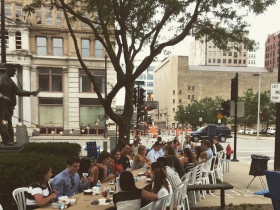
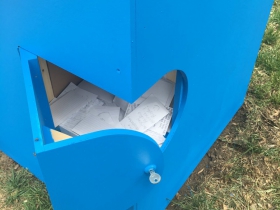
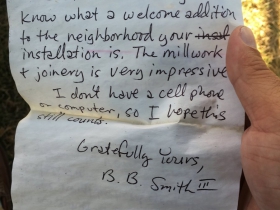
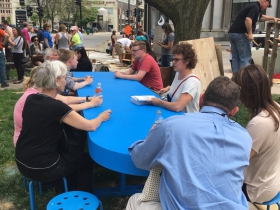
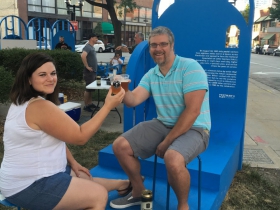




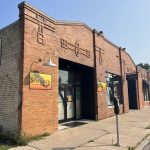

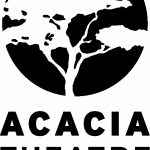

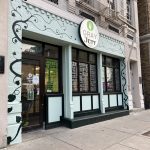
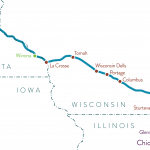
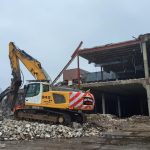




I think Dick Blau’s “op-ed” was far too negative and made little attempt at verifying many of his claims.
Was the installation at Postman’s Plot perfect? Maybe not, but what is? The fact is that it was a cost-effective way to explore how people could use a space that was largely unused and ignored (without needing to hire a nationally known architecture firm).
I would call this experiment a resounding success. Hats off to Newaukee for working with the city to try something different. Future iterations of public art spaces in Milwaukee are better for it.
I swear in 25 yrs I never noticed that space till the blue furniture arrived this summer. Nice job Newaukee!
“Two things that Milwaukee needs to do in order to move forward: to invest more deeply in connectivity and to finally shed our collective aversion to risk.”
People don’t need risk in public spaces. They need chairs someone actually wants to sit it. Doesn’t matter what color they are.
Regarding the buzz word “Connectivity” — it is built into the very nature of cities. Think of all the coffee shops, bars, micro breweries, and restaurants in Milwaukee. The Pop Up Beer parties are for the suburbs.
Speaking of new “public” spaces, what input from prospective users is happening with the design of Bucks Plaza–before many millions are spent? Will there be any public process?
The Riverwalk’s many stairs seem to pose more challenges for bikes than its width. Or when restaurants encroach on public accessibility.
According to a 10/15 audit,O’Donnell Park is widely used despite the fact that the county has not programmed ANY events there in a decade. It’s also been documented that O’Donnell is the number-one spot for tourists to take photos in downtown Milwaukee. Auditors visited the park at different times and observed people using the space in many ways.
http://county.milwaukee.gov/ImageLibrary/Groups/cntyAudit/2015-Reports/ODonnellPark-ORIGINAL10-13-15.pdf
Simply doing better maintenance and some programming would much improve O’Donnell’s “functionality.” A restaurant that keeps regular hours would also help draw more people, especially locals.
Some suggestions below to enhance O’Donnell are also relevant to other shabby public spaces.
“Going back to Project for Public Spaces criteria for a successful
public space, O’Donnell’s prime lakefront location definitely
makes the site accessible, providing a link from the central
business district to the lakefront. However, as shown earlier in this
Section, small changes—including an increased focus on keeping
up the landscape and repairing worn benches—could help to
make the park more comfortable.
Small changes at O’Donnell like better upkeep of the landscape and
replacement of worn benches would help to make the park more inviting.
ZHG’s proposal included the following suggested park improvements:
Improve signage (highlight Gold Medal Park Winner)
Have parking stations in full operation (and remove the non-working prepay station in the lobby)
Keep facility clean, including the lobby and stairwells
Maintain the lawns
Level the gardens to make outdoor events and tenting easier
Keep lighting consistent
Maintain or replace trees, bushes and beds
Plant flowers with height and color
Repaint railings”
Virginia, I am confused by you post here. Might is be for another story?
Kudos to Dick Blau for his decision to take on the art installation in Postman’s Plot. Love it or hate it, and it is art; ignore it, and it is blue furniture. Mr. Blau has asked us to make up our minds. I choose agree that it is art, just not very good art.
I live in the neighborhood and pass by Postman’s Plot almost daily, so I have a little skin in the game. Although I am appreciative of the fact that NEWwaukee has taken an interest, their first foray into the public art business has come up short. It has that “art by committee” look, as if each separate piece was voted in during a late night meeting leaving absolutely no sense of a coherent whole, let alone any emotional valance.
To my wife and I as we walk by it, there is instead a feeling of “who put this here and when are they going to move it?”
Art, even public art, should move the viewer in some fashion. Blessed with this little plot of land deep in the heart of urban Milwaukee, we are better served by patience and discrimination rather than, as Mr. Blau observed, catering to “enthusiastic proposals for filling up the space.”
In its defense, Jeremy Fojut enumerated a list of positive responses to the installation that, in fairness, ought not go unnoticed. Of concern to me as a property owner-resident in the neighborhood, however, is his assumption that any installation ought to “change the way people connect.” As an example he touted the little park’s use as a “pop-up beer garden.”
Really? The “findings” tell you that area needs more places to drink beer? Perhaps if NEWwaukee is truly interested in finding a purpose for Postman’s Plot so as to better inform the art, they could survey and even converse with the permanent residents of the neighborhood. Positive outcomes tend to follow decisions based on data rather than just conjecture. I fear that failure in this regard will risk the emergence of yet another space filler.
Jim Larson
Yes, the original op ed was very negative. But I have to say, as a professional artist, empty catchphrases like this:
” the design utilizes a series of interventions that serve as a toolkit for social engagement”
Just tick me off. And I know I’m not alone.
The ‘shocker’ result that NEWwaukee found out? People like tables and chairs to sit in.
That doesn’t require people watching the space and taking photos and logging activity.
And it doesn’t require that temporary, ugly, disposable furniture be created just in case people don’t actually like to sit in chairs at tables outside.
Excellent response based on logical data collection. If only other people would give their opinion AFTER doing a little research.
This is a valuable dialogue on public spaces.
The Postman sculpture needs to remain the focus of the triangular park; the most important need for the space is well maintained places for people to sit. That is what will bring “connectivity” to this public space! Well maintained benches, trash cans, and lighting are essential as well. With those items in place NEWaukee will achieve its goal of bringing people together, if that is really their goal.
Tom, my comment was in response to paragraph 7 specifically, and about upgrading existing public spaces–the topic of this op-ed.
The O’Donnell study by Jerome Heer and his staff involved much data collection, including about space-use patterns as well as info about plazas in other cities. I don’t recall anyone reporting on the O’Donnell audit. Some Urban Milwaukee readers might find it relevant.
By the way, for years Urban Ecology has done space-use studies in the parks in which they work (with the help of volunteers). That data is all open source and drives UEC”s decision making about how to serve current and potential park users and enhance those public spaces.
As a resident in a nearby building with a dog, it’s pathetic to see what other dog-owning neighbors have done to this plot. I firmly believe they’re solely to blame for the lack of participation. You can’t walk six feet in the grass without stepping in or having to navigate around dog waste, even after a waste receptacle and waste bags were provided. Whether it’s laziness or an act of defiance, no effort is put in to do what every responsible dog owner does multiple times daily.
On top of that, I tried to use one of the adirondack chairs to rest after a jog and couldn’t because of the stench of urine. Who wants to hang out in a park taken over by irresponsible dog owners?
I think the city should send a message and enforce not picking up the dog waste. It’s a biological hazard for other dogs and is ruining an innovative idea in an underused public space.
Brian, Your point is well taken and not just in this park. As I recently walked from the Milwaukee Art Museum to my car parked on Lincoln Memorial Drive, I took a shortcut through grassy areas. I could not believe how littered with dog waste it was. I had to gingerly walk to avoid excrement, and this is a very large expanse. There needs to be some serious re-education among stewards of dogs.
Milwaukee Native: Agreed. If the police treated it half as seriously as how our parking checkers treat violations, the problem would be gone in weeks! This is only the bottom 10% of dog owners creating the issue; scan through all of the nearby dog parks and there will be no piles to speak of. I would love to see an Editorial highlighting this.